
fter Clifford Allbutt introduced his compact clinical thermometer in 1866 (he halved the standard length from a Heimlich-ready 12 inches down to 6), the English physician approached medical-instrument maker Harvey & Reynolds to manufacture and sell the temperature-taking technology. Even though the slim mercury-filled tube could record a person's body temperature within a blazing-quick five minutes – four times faster than other contemporary devices – Harvey & Reynolds decided to market it not by touting its innovative features but by brandishing the inventor's illustrious name. Called Dr. Clifford Allbutt's Clinical Thermometer, the amazing apparatus attracted attention from the public and physicians alike through the gilded name of a doctor renowned as an expert on arterial disease.
But if slapping some celebrity doctor's name on its devices was all it took, Arizant Healthcare Inc., a 3M Company, could have stuck Dr. Phil's or Sanjay Gupta's moniker on its SpotOn temperature-monitoring system and called it a day. Instead, the Maplewood, MN-based firm faced a marketing challenge as daunting as fighting the bubonic plague with a bottle of NyQuil and a big box of Kleenex.
Diagnosing the Problem
Owned by 3M Co. since 2010, Arizant needed an innovative way to launch its new SpotOn system, an advancement in temperature-monitoring technology. In short, SpotOn isn't your great-grandfather's thermometer. It was, in fact, almost as dramatic a leap over current technology as Dr. Allbutt's thermometer was. It offered hospitals and clinics a noninvasive way to measure patients' core body temperature before, during, and after surgery as accurately as other invasive devices. Those instruments, while precise, often have to be inserted into the esophagus, bladder, or other areas where intrusion by a foreign object is uncomfortable. But with SpotOn, medical professionals simply attach a disposable sensor to a patient's forehead for an entire surgical procedure. (The sensor is then reconnected to control units at each point of care.) Additionally, most hospitals carry an average of five traditional temperature-monitoring devices, which increases costs for medical facilities and heightens complexity for their staff. By relying solely on the SpotOn system, facilities can simplify the process, receive more consistent readings, avoid distressing patients, and even reduce operating expenses.
Its technological superiority and cost savings didn't mean SpotOn would be a no-brainer to market, however. It would carry the 3M name with all of that brand's implied eminence – according to research by the Reputation Institute, the public ranks 3M as the fourth most-reputable company in America – but SpotOn wouldn't be running onto an open playing field of virtually no competitors as Allbutt's device did in 1866. Nearly 150 years after his thermometer debuted, there are almost as many temperature-taking systems as there are medical ailments.

Arizant Healthcare Inc. wove colorful thermographic imagery into its print ads, mailers, billboards, websites, street teams, videos, and literature.
The market itself is as jammed as a big-city ER, with nearly 80 companies competing for a piece of a financial pie that should reach $866 million by 2017, according to a report by Global Industry Analysts Inc.
Pre-Op Planning
Just as surgery should take place in a setting optimized for its success, the marketing for SpotOn's launch had to occur in a venue where Arizant could most be assured of, as doctors might say to a nervous patient, a positive outcome. For Arizant, that meant the 2013 Association of PeriOperative Registered Nurses (AORN) Congress in San Diego. Boasting a 2012 attendance nearing 5,000, the show attracts a hugely influential audience the way a Star Trek convention draws geeks. In recent years, an average of about 40 percent of AORN attendees carried the title of manager, director, or some other heavy-hitter position above those. More than 71 percent are typically involved in purchasing decisions, and roughly 45 percent recommend new products to the institutions they represent. "If there's one place to impress nursing decision-makers, it's AORN," says Troy Bergstrom, Arizant's marketing communication manager. "As the industry leader in temperature management, we wanted to bring our 'A' game to this particular show."
But like curing the common cold, bringing its "A" game was easier said than done. For one, the company's $46,000 budget for AORN was as tight as a stitch. Moreover, a crowded field of more than 500 exhibitors would be vying for the attention of attendees, 77 percent of which spend eight hours or less on the show floor. But Arizant faced yet more obstacles than just a skeletal budget and time-starved attendees. Instead of having its own booth at the show, the company would be exhibiting inside the 3M booth. There, the SpotOn system would be demonstrated in three separate areas. At first blush, that may sound more than sufficient, but the reality was SpotOn would be surrounded by dozens of other 3M products, putting it in the unenviable position of a stuffed toy trying to stand out in FAO Schwarz at Christmastime.
If, as Shakespeare suggested, embracing adversity is the wisest course, Arizant gave it a crushing

A 9.5-by-20-foot, dual-sided mobile billboard extended Arizant's reach through San Diego's hotel and tourist districts.
bear hug. Spurred by necessity, the company brainstormed a strategy of creating basic but indelible imagery. That approach would ignite Arizant's marketing effort, allowing it to consistently integrate the same visual content into a range of promotional and marketing media – mailers, print ads, online content, videos, and so forth. Done right, it would stand out from traditional text-heavy health-care promotions that often resemble legal documents more than they do marketing pieces. Furthermore, Arizant hoped, the effort would draw attention with the power of a temperature-taking tractor beam.
Prescribing an Image
The debate over what kind of image to use took about as long as getting a flu shot. The company immediately settled on using a thermographic image of a woman's face glowing in hues that represented the levels of heat emitted in different areas. Cleverly, the image mixed something connected to the product's function with a pleasant side effect of being visually striking.
Like surgeons scrubbing up before the main event, Arizant initiated its trade show marketing with something equally basic: pre-show mailers dispatched to approximately 2,300 attendees – about 47 percent of AORN's expected attendance. Sent approximately 10 days before AORN opened its doors, the mailers displayed the female visage colored in shades of turquoise, jade, coral, and violet representing different levels of heat. Sporting the snappy tagline "Some people just look at the surface. We go right to the core." the mailer cheekily played on SpotOn's core-temperature monitoring, while supporting text and a microsite URL added information on its simplified yet accurate ability to take and record patients' temperatures.
That pre-show mailer was paralleled by a print-ad campaign. Using identical heat-themed imagery and content as the snail-mail campaign, Arizant ran the advertisements in a quintet of prominent publications (AORN Journal, Critical Care Nurse, Journal of PeriAnesthesia Nursing, Anesthesiology News, and the AANA Journal) whose combined circulation totaled approximately 200,000 readers. Like the mailers, the print ads referred their audience to the SpotOn microsite, which also integrated the same heat-themed imagery.
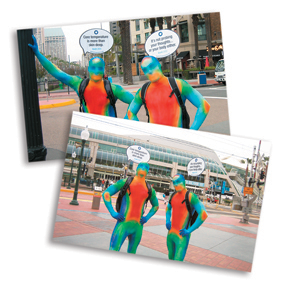
Street teams dressed in "morphsuits" engaged attendees outside the convention center by inviting them to pose for photos holding one of several SpotOn thought bubbles.
Bypass Procedure
Arizant's mailers and print ads were a good start, but the key to this operation, so to speak, was to reach people before they hit the show floor, where attention spans dissolve as fast as chewable aspirin. But given the company's anemic budget, many options (such as giant banners hung in and around the convention center) were off the operating table. Thankfully, Arizant hit on the inspired idea of moving billboards and roving street teams to engage attendees before anyone else could. These mobile promotions would create a vector through which to touch thousands of attendees before the show opened, and stay close to the company's austere bottom line.
On AORN's first two days, Arizant arranged for a two-sided billboard with a thermographic-themed ad measuring 9.5-by-20-feet on each side to be towed around, from the show hotels to the San Diego Convention Center to the tourist-heavy section known as the Gaslamp Quarter, the historic heart of the city where trade show attendees go to chill and carouse. The move was another in a series of Brainiac-level strategic decisions by Arizant. In Arbitron Inc.'s study of the effectiveness of billboards, 24 percent of consumers reported an outdoor ad message spurred them to immediately visit the advertised business. Given the billboard's intense kaleidoscopic imagery, the immediate relevance it had to its target audience, and the fact that those attendees would be in the general vicinity of Arizant on the show floor anyway, the company hoped the billboard might catapult a sizeable number of them into the 3M booth where it was promoting SpotOn.
What Arizant started with wheels, it continued with legs. A street team, it reasoned, could pique even more curiosity and thus help raise awareness and drive attendees to the booth. Arizant could have
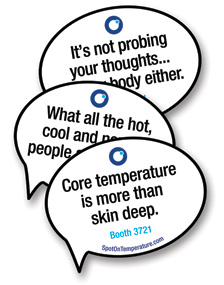
The white thought bubbles featured the SpotOn microsite URL as well as tongue-in-cheek messages related to temperature.
fallen back on the standard formula that often defines street teams: a small group of people in branded T-shirts who shill for a company in some attention-getting way that combines the decibel level of cheerleading with the I'm-stuck-in-a-box preciousness of street mimes. But instead, Arizant souped up the formula with the ingenuity of an auto mechanic figuring out how to coax 500 horsepower out of a Smart car. Rather than outfitting the street team with cheaply printed T-shirts, Arizant went full couture, hiring a local body-painting artist, Chris Elliman, who boasts an edgy clientele from the Comic Con trade show to Vice magazine. Riffing on the thermal imagery Arizant had now used across four different venues (i.e., mailers, print ads, the microsite, and mobile billboards), Elliman colored a trio of custom "morphsuits" (nylon/spandex garments that cover the body from head to toe) for the street team as brightly as a vase of Van Gogh's sunflowers. Donning the "morphsuits" and looking the way human forms would through the eerie glow of infrared goggles, the team worked eight-hour shifts for the show's first two days.
Here, too, Arizant exercised the acuity that put its efforts far above humdrum marketing campaigns. Instead of just directing the models to walk the streets and hand out branded fliers, Arizant found a way to make the team as engaging and entertaining as the Blue Man Group. The company furnished each model with "thought bubbles" – in reality, 16-by-12-inch pieces of fluted Coroplast cut into the shape of cartoon characters' thoughts that the street team carried in their backpacks. When the team approached attendees outside the convention center or in the Gaslamp Quarter, they didn't sprint through a rote greeting and routine invitation to visit the exhibit. Instead, they simply directed attendees to the 3M booth, then pulled out the thought bubbles and asked people to pick their favorite. The bubbles featured Arizant's booth number and "punny" messages such as "Core temperature is more than skin deep," "What all the hot, cool, and normal people are wearing," and "It's not probing your thoughts, or your body either."
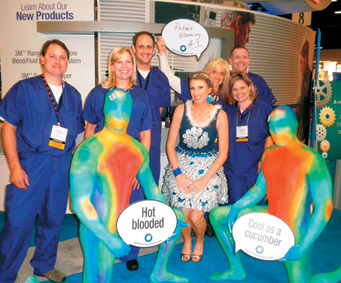
Visitors who strolled into Arizant's booth during the reception were greeted by the colorful street team, eight booth staffers clad in purple scrubs, and one staffer draped in a custom-made dress sparkling with SpotOn system sensors.
When they weren't laughing, attendees were taking up the street team on its offer to pose for photos with them and the message of their choice. After snapping a few pics (on participants' own cameras), the team members asked attendees to then share the pictures on Twitter, Facebook, and any other social-media sites they frequented. The interaction worked on multiple levels. First, it offered a means to alert attendees to SpotOn's debut by using humor instead of a hard sell. Second, when those attendees posted photographs of themselves on their social channels, they became de-facto promoters for SpotOn, helping up the awareness ante.
Operation Dress for Success
Estimating that several hundred attendees encountered the billboards and/or street team, Arizant felt it had an audience primed for its appearance at AORN. Even so, the company knew it could still get lost inside 3M's 2,400-square-foot space the way the lesser mountain peaks of the Himalayas can be swallowed by the shadow of Mount Everest. Thus, it pulled more marketing magic out of its hat by piggybacking on a standing event that would be dense with attendees: AORN's opening-night reception held in the exhibit hall, where attendees mingled with each other and explored the show's exhibits at leisure.
During the reception, visitors who strolled into 3M's booth were greeted by the colorful street team, along with eight staffers clad in purple scrubs that stood out against the sea of casual-nice dress. Always riffing and adding new twists, Arizant created a different set of temperature-related thought bubbles to foster an expanded interaction at the soiree. The staff and street team asked visitors to choose their favorite from a batch of bubbles that included "Cool as a cucumber," "Hot blooded," and "Hot or not." Arizant used its own camera – in addition to visitors' devices – to photograph the guests grasping their bubble of choice, often posing alongside the street team whose intensely colored garments suggested Jerry Garcia and shrooms had been involved in their design.
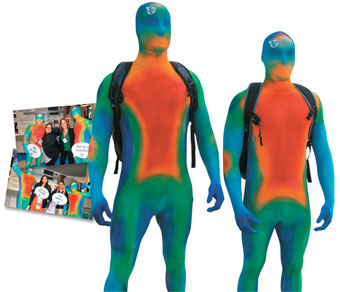
Staffers snapped photos of attendees posing with the street team, and encouraged people to share the pics on social-media sites.
With attendees' permission, Arizant then posted the photos to the 3M Infection Prevention social-media pages, including Facebook, Twitter, and Google+. Just as they had been outside the convention hall, guests were encouraged to share these pics with their online friends and followers, too. Since the thought bubbles also included the SpotOn system's microsite address, every picture reposted or forwarded by attendees provided Arizant with another way to promote its new product, and drive traffic to the site. Meanwhile, a 60-second product-launch video using the thermal imagery played in the background.
If attendees' attention started to flatline, it was galvanized again with a promotional defibrillator Arizant hauled out: a staffer draped in a custom-made dress sparkling with SpotOn system sensors. Requiring more than 20 hours of handiwork by two people, the one-of-a-kind gown consisted of more than 1,000 SpotOn system sensors overlaid on a cotton dress. The gorgeous garb was Arizant's perceptive nod to the show's mostly female demographic.
Following the reception, Arizant's in-booth experience during official show-floor hours remained mostly unchanged. The omnipresent thermographic imagery acted as an icebreaker, and mental bridge connecting the mailers, ads, billboards, street team, and device-clad dress that Arizant estimates that hundreds of attendees had likely already been exposed to before setting foot in the booth. Thus it made little difference that there was no specific, labeled booth designated for SpotOn.
Visitors could, however, see the system set up in three separate areas inside the 3M space. There, attendees watched the minute-long video presentations on a trio of 52-inch LED monitors positioned around the exhibit, while staffers engaged them, qualified those who were solid leads, and explained more about the SpotOn temperature-monitoring system.
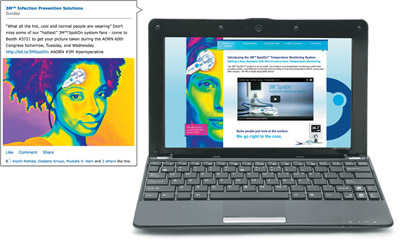
Arizant posted messages and pictures from the show floor on its Facebook page with a link to the microsite, where visitors could watch a video and learn more about SpotOn.
Promotional Post-Mortem
Arizant succeeded wildly in making what one Sizzle Awards judge called "a lasting impression." "This could have been really boring," another judge added, "but Arizant made it incredibly memorable and exciting." Indeed, Arizant's integrated marketing strategy unfolded with the grace and symmetry of an origami sculpture.
Using catchy, product-related imagery consistently and mixing it with street teams, billboards, and more that created multiple touchpoints for thousands of attendees paid off handsomely. Aiming for 100 high-quality leads, Arizant pulled in 175, exceeding its goal by a rather remarkable 75 percent.
Arizant's success on the Internet and social-media front was equally impressive. By AORN's end, Arizant had hoped to double traffic to its various websites, and encourage 100 attendees to engage with show- and SpotOn-related content through likes, comments, and shares. The company easily sprinted past those objectives with the speed of Usain Bolt, scoring gains of 700 percent and 400 percent, respectively.
The novelist John Updike once counseled that challenges and problems, in small doses, can have the same effect as a vaccine, strengthening our immune system to the hazards that befall us. Hobbled by a needle-thin budget, behemoth competitors, and no formal booth space to launch its new technology, Arizant overcame its difficulties with gusto, and emerged from AORN the picture of perfect health. 





 fter Clifford Allbutt introduced his compact clinical thermometer in 1866 (he halved the standard length from a Heimlich-ready 12 inches down to 6), the English physician approached medical-instrument maker Harvey & Reynolds to manufacture and sell the temperature-taking technology. Even though the slim mercury-filled tube could record a person's body temperature within a blazing-quick five minutes – four times faster than other contemporary devices – Harvey & Reynolds decided to market it not by touting its innovative features but by brandishing the inventor's illustrious name. Called Dr. Clifford Allbutt's Clinical Thermometer, the amazing apparatus attracted attention from the public and physicians alike through the gilded name of a doctor renowned as an expert on arterial disease.
fter Clifford Allbutt introduced his compact clinical thermometer in 1866 (he halved the standard length from a Heimlich-ready 12 inches down to 6), the English physician approached medical-instrument maker Harvey & Reynolds to manufacture and sell the temperature-taking technology. Even though the slim mercury-filled tube could record a person's body temperature within a blazing-quick five minutes – four times faster than other contemporary devices – Harvey & Reynolds decided to market it not by touting its innovative features but by brandishing the inventor's illustrious name. Called Dr. Clifford Allbutt's Clinical Thermometer, the amazing apparatus attracted attention from the public and physicians alike through the gilded name of a doctor renowned as an expert on arterial disease.











